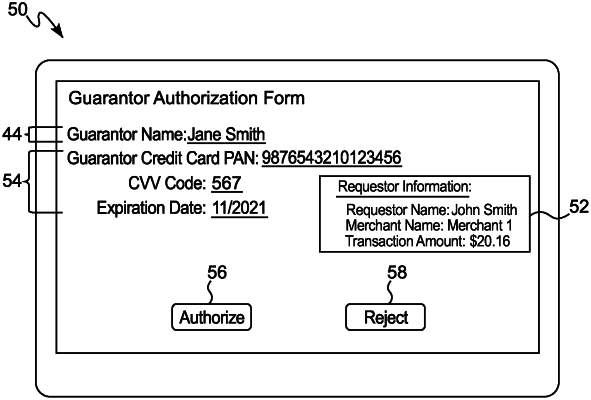| CPC G06Q 20/102 (2013.01) [G06Q 20/065 (2013.01); G06Q 20/4014 (2013.01); G06Q 40/02 (2013.01)] | 8 Claims |

|
1. A method for processing a payment transaction via a proxy guarantor, comprising:
receiving a transaction request from a merchant website of a merchant system that only accepts electronic payments involving credit accounts, wherein the transaction request is generated by the user by engaging with a graphical user interface of a computing device of the user, wherein the transaction request comprises a transaction amount and an indicator from the merchant website,
wherein the transaction request is a modified transaction request, modified from a transaction request generated for a transaction that does not trigger the proxy transaction protocol,
wherein the modified transaction request comprises an indicator of the user selection of a selectable option of the proxy transaction protocol,
wherein the selectable option is displayed by the merchant website on the graphical user interface of the computing device of the user, and
wherein the modified transaction request triggers processing of the payment transaction, using the proxy transaction protocol and using the payment device of the user issued for the debit account, and without using a payment device of the user issued for a credit account;
in response to receiving the transaction request, initiating, with at least one processor, a payment transaction between a user and the merchant system, wherein a payment device of the user is used during processing of the payment transaction, and wherein the payment device of the user was issued for a debit account and not issued for a credit account;
triggering, with the at least one processor, a proxy transaction protocol in response to receiving the transaction request;
in response to the triggering of the proxy transaction protocol, generating a proxy selection message, and communicating, with the at least one processor, the proxy selection message to the computing device of the user that, when received by the computing device of the user, displays a proxy selection interface on the graphical user interface of the computing device of the user;
receiving, with the at least one processor, from the computing device of the user, a proxy selection response based on user input to the graphical user interface of the computing device of the user, the proxy selection response comprising:
payment device data of the payment device of the user, wherein the payment device was issued for the debit account; and
guarantor data identifying a guarantor different from the user and having a credit account different from the debit account;
during processing of the payment transaction, and prior to communicating an authorization request to an issuer system:
generating, with the at least one processor, a message comprising user identifying data of the user,
communicating the message comprising user identifying data to a computing device of the guarantor based on the guarantor data that, when received by the computing device of the guarantor, displays the user identifying data of the user and a selectable authorize option on a graphical user interface of the computing device of the guarantor, and prompts the computing device of the guarantor to generate a response message, based on input from the guarantor to the graphical user interface of the computing device of the guarantor by selecting the authorize option, and
receiving, with the at least one processor, the response message from the computing device, of the guarantor indicating authorization by the guarantor, the response message comprising payment device data of a payment device of the guarantor issued for the credit account;
in response to receiving the response message, and based on the payment device data of the payment device of the guarantor issued for the credit account, generating, with the at least one processor, a hold request, and communicating the hold request to an issuer system that issued the credit account, wherein the issuer system that issued the credit account corresponds to the credit account of the guarantor, and wherein the hold request causes the issuer system that issued the credit account to place a hold on the credit account for at least a portion of the transaction amount;
in response to the hold being placed on the credit account, generating, with the at least one processor, an authorization request, and communicating the authorization request to an issuer system that issued the debit account, wherein the issuer system that issued the debit account comprises an authorization server and corresponds to the debit account of the user, and wherein the issuer system that issued the debit account is different from the issuer system that issued the credit account;
receiving, with the at least one processor, an authorization response generated by the authorization server of the issuer system that issued the debit account, the authorization response comprising an authorization approval;
communicating, with the at least one processor, a hold removal message to the issuer system that issued the credit account that, when received by the issuer system that issued the credit account, causes the issuer system that issued the credit account to remove the hold on the credit account; and
during settlement of the payment transaction, transferring the transaction amount from the debit account to an account of the merchant system.
|